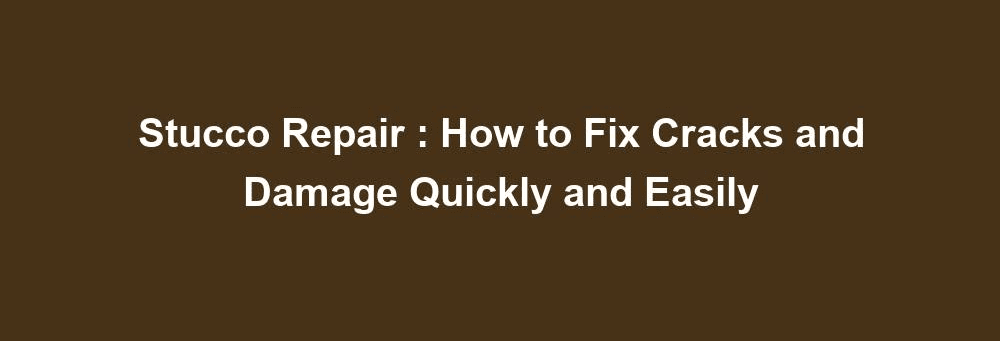Stucco repair in a drywall can be a simple DIY project or a complicated mess if not approached with the right knowledge and tools. In order to successfully repair stucco in a drywall, it is important to understand the basics of stucco and have the necessary tools and materials on hand.
With just a few tools and some material knowledge, anyone can patch and repair stucco with ease. This article will cover everything from repairing hairline cracks to larger scale stucco repair in a drywall, as well as important tips for stucco repair and cleaning up spills.
Key Takeaways
- Understanding the basics of stucco and having the necessary tools and materials is crucial for successful stucco repair.
- From repairing hairline cracks to larger scale stucco repair, this article covers everything you need to know to tackle any stucco repair project.
- Important tips for stucco repair and cleaning up spills are also included to ensure a successful and stress-free repair process.
Stucco Repair
Stucco exteriors are known for their insulating properties, fire retardancy, and noise reduction capabilities. Properly installed stucco can last for over a century. However, cracks and holes can develop over time, and it is essential to repair them promptly to prevent further damage. Peeling, flaking, and uneven surfaces are signs that stucco repair may be needed. Discoloration can also indicate the need for repair.
Regular monitoring of stucco exteriors can help detect issues early, preventing costly repairs in the future. Proper maintenance and timely repairs can ensure that stucco exteriors remain attractive, durable, and energy-efficient.
Repairing Hairline Cracks in Stucco
Pre-Mixed Stucco Patch Material
For larger cracks or small holes in the exterior stucco wall, it is recommended to use a pre-mixed stucco patch material. One can purchase a store-bought pre-mixed stucco patch and use a trowel or small putty knife to fill the crack with the stucco patch. It is important to follow the manufacturer’s recommended time for the patch to set.
Multiple layers may be required to fill the stucco crack repair completely, so it is flush with the rest of the wall. It is important to follow the manufacturer’s instructions for a successful repair.
Pro Tip:
Quikrete Stucco Repair is a weather-resistant formula that has great flexibility and adhesion. It can be used to fill and seal cracks in stucco up to 1/2″ wide. There is also a Quikrete Stucco Repair sealant that can be applied with a caulk gun for crack filler and stucco siding repair.
When using pre-mixed stucco patch material, it is important to note that the color may not match the existing stucco. Therefore, it is recommended to paint the entire wall after the repair to ensure a uniform appearance.
Overall, using pre-mixed stucco patch material is a simple and effective way to repair larger cracks or small holes in the exterior stucco wall.
This might interest you: Repair Drywall Screw Pops
What to Do for Larger Scale Stucco Repair
Water Damage Behind Stucco Cracks
When larger cracks appear in stucco siding, it can lead to water damage behind the stucco wall. Water can collect in these cracks and eventually soften the stucco, causing it to crumble or fall off in sheets. This can be a serious problem for homeowners, as water damage can cause significant structural damage to the home.
If you have noticed larger cracks, holes, or pieces of stucco that are crumbling, it is important to address the issue as soon as possible. Homeowners can contact a stucco repair contractor or a handyman in their area for an estimate. A professional who is experienced with stucco wall repair could be the best option.
However, for those who are comfortable with DIY projects, it is possible to save money by doing the stucco repair themselves. To start, homeowners will need a utility knife and the basics for a DIY stucco repair job.
It is important to note that if the water damage behind the stucco cracks is severe, it may be necessary to remove the damaged stucco and replace it with new stucco. This is a job that is best left to professionals, as it can be complex and time-consuming.
To prevent future water damage, homeowners should also consider waterproofing the stucco. This can be done by applying a waterproof sealant to the stucco surface. This will help to prevent water from seeping into the cracks and causing further damage.
Homeowners should take swift action when larger cracks appear in stucco siding to prevent water damage behind the stucco wall. They can contact a professional for an estimate or attempt a DIY repair job. It is important to take steps to prevent future water damage by waterproofing the stucco.
What is Stucco and How to Make It
Stucco is a plaster made from either lime or cement that is commonly used for exterior wall finishes. It is applied in a three-coat system to ensure proper setting, sealing, and insulation. The three-coat system consists of two base coats and a finish coat. The first coat, called the scratch coat, is followed by the brown coat, and then the finish coat.
Mixing Stucco
There are many different stucco coat recipes available, depending on the type of material and building being plastered. In general, stucco is made by mixing cement and sand together in different proportions, depending on the coat. The first coat, or scratch coat, is made with 1 part cement to 2 ¼ – 4 parts cement. The second coat, or brown coat, is made with 1 part cement to 3 – 5 parts sand. The finish coat is made with 1 part cement to 1 ½ – 3 parts sand.
Basic Recipes for Stucco Mix:
Here are some basic recipes for stucco mix:
First Coat:
- ½ bag (47 lbs) Portland cement
- 6 shovels brick or mason’s sand, slightly damp
- 1 shovel hydrated lime
- ½ cup acrylic bonding agent
Second and Finish Coats:
- ½ bag (47 lbs) Portland cement
- 8 shovels aggregate sand for concrete
- 1 shovel hydrated lime
- ½ cup acrylic bonding agent
Stucco Mix Directions:
- Put all dry ingredients into a wheelbarrow and mix them together with a hoe.
- Add the acrylic bonding agent, then mix in water, a little at a time, until the mixture reaches the consistency of thick cake frosting (too much water will make the stucco mix loose and unusable).
- Once properly hydrated, the mix can be used for 30 to 90 minutes before it begins hardening.
These instructions and proportions are a base recipe that can be modified for your project. If you need to cover fewer square foot areas for your stucco mix, cut the stucco mix recipes down accordingly.
Stucco is a plaster made from either lime or cement that is commonly used for exterior wall finishes. It is applied in a three-coat system, consisting of two base coats and a finish coat. The scratch coat is followed by the brown coat and then the finish coat. Stucco mix recipes vary depending on the type of material and building being plastered, but the basic recipe involves mixing cement and sand in different proportions for each coat.
How to Repair Stucco
Stucco is a popular exterior wall finish that can last for decades. However, over time, it can crack or become damaged, which requires repair. Here are the basic steps for repairing stucco.
Step 1: Remove Broken or Loose Stucco
The first step in repairing stucco is to identify and remove all broken or damaged stucco. This can be done using a hammer or a hammer-and-cold chisel, but care must be taken not to damage any of the wooden structure behind the stucco. Protective eyewear is a must in this step. Depending on the accessibility and location of the repair, scaffolding may be needed to ensure access to the entire damaged area.
Step 2: Keep Chipping at the Edges
Continue breaking away pieces of damaged stucco until you get to nothing but solid, firmly attached stucco. This step ensures that there isn’t any loose or damaged stucco around the edges of the repair.
Step 3: Inspect/Replace Metal Mesh
Once the damaged stucco has been removed, inspect the metal lath beneath for damage or signs of rust. If it appears to be in good condition, new stucco can be applied directly to the mesh. If the old mesh is damaged, remove it with metal snips. Trim a piece of grade-D builder’s paper to fit snugly in the stucco opening and affix it to the wooden lath with roofing nails. Apply a second layer of paper. Place galvanized metal mesh over the paper and trim it to fit tight against the edge of the stucco. Drive more nails through the mesh to secure it against the wood lath.
Step 4: Mix a Batch of Stucco
To make a batch of stucco mix, use the first coat recipe. Modify the quantity to make as much as you need to use within a short window since the mix will dry and harden beyond use within a couple of hours. Wear gloves when mixing stucco and avoid touching fresh stucco with bare skin. The alkalis in stucco mix can cause burns. Keep a hose or water bucket nearby to wash off any exposed skin touched by fresh stucco.
Step 5: Apply New Stucco
Wet the edges of the existing stucco to ensure better adhesion and to prevent the old stucco from sapping the water from the new layer. Scoop wads of wet stucco into a masonry trowel and sling them at the mesh until the mesh is covered. Smooth the mix with a trowel and pack it against the edge of the existing stucco. Keep adding more wet stucco until this layer is about ½ inch below the stucco exterior.
Step 6: Scratch the Scratch Coat
The coat just applied is the base coat or scratch coat. After a few minutes, once the wet stucco loses its wet sheen, scratch a series of X patterns into the scratch coat using the edge of a trowel. This scoring helps improve the adherence of the second, brown coat. Once scored, tape a plastic sheet over the area to prevent it from drying out too much. The scratch coat will need sufficient time to cure in order to become rigid enough to stop cracking and be ready for the second coat. This cure should last around a week or seven days.
Step 7: Apply the Brown Coat
After the first curing period, mix together a batch of stucco for the brown coat. Remove the plastic sheet, mist the patch with water, and apply a ¼ to ⅜ inch layer of brown coat. Once the wet sheen dissipates, smooth the layer just below the existing stucco, being sure to pack down the edges. Cover again with a plastic sheet for another curing period. This cure should only take about three days.
Step 8: Apply the Finish Coat
After the cure, remove the sheet and mist the patch with water from a spray bottle. Mix up a batch of finish coat using the finish coat recipe as a base, and apply. Do your best to apply this top coat flush with the existing wall, making the entire surface smooth. This step is also where the stucco gets its distinctive textured finish. Different methods of application result in different types of finish. The traditional, stippled, and rough texture of stucco can be replicated using a damp cloth or sponge.
Step 9: Let the Finish Coat Cure Before Painting
Now that the stucco has been applied and repaired, it is important to wait before painting to create a seamless finish. This layer, like the others, needs time to cure before paint of any kind can be applied. Wait a week before painting.
These basic steps can help you repair stucco.
Important Tips for Stucco Repair
Weather and Stucco
To ensure the structural integrity of stucco, it is important to keep wet stucco at a minimum temperature of 40℉. It is recommended to wait for a time when nighttime temperatures are above 40℉ before applying stucco. In case the stucco needs to be kept above that temperature, it can be covered and the building can be heated. However, it is crucial to not let the stucco freeze within 48 hours of application, as this can damage its structural integrity.
Finishing Stucco
Matching the color of freshly applied stucco to existing stucco can be difficult. While it is possible to add mortar colorants to wet stucco mix to tint them, it may not exactly match the color of the existing stucco. The best way to perfectly match a color is to cover the stucco with a pigmented coating of some sort. This can be anything from concrete paint to a fog coat to the sprayed-on acrylic elastomer. All of these methods are effective ways to color and tint the exterior finish of stucco.
Cleaning Stucco Repair Spills
Spills are an inevitable part of stucco repair projects, but they can be easily cleaned up with the right tools and techniques. If left unattended, spilled stucco can harden and stain concrete and wooden flooring. To clean up wet spilled stucco, it is recommended to soak the area with a wet cloth for 10 to 15 minutes until saturated. While wearing eye protection and gloves, break up the stucco with a chisel and mallet, particularly if it is a large spill.
Scrape up the spill with a wire brush and dispose of the stucco properly. If the stucco leaves behind a stain, mix one part vinegar to five parts water and spray the affected area with the mixture. Scrub the area with a wire brush until the stain is gone. Rinse the area thoroughly to complete the cleaning process.
Synthetic Stucco
EIFS, also known as synthetic stucco, is a plaster option that can replace old traditional stucco. Traditional stucco is more susceptible to cracking, while EIFS is much more crack-resistant because it bonds together with a protective finish that doesn’t breathe. However, moisture can get trapped behind the entire wall of EIFS, causing damage to the structure and possible bigger problems down the road, so it’s critical to follow proper installation methods.
Be Careful with Old Traditional Stucco
If dealing with an old building with its original stucco intact, it’s possible the building has traditional stucco. Stucco contractors can quickly identify old traditional stucco, but it’s possible to do it yourself. New stucco is made with a similar mixing method but uses Portland cement as the main material rather than the traditional, softer lime. Lime is added to new stucco to make it more workable, whereas traditional stucco is made with exclusively lime, sand, and water.
It’s important to check old stucco to see if it’s made the traditional way before beginning to repair stucco that’s Portland cement-based. One can do this by taking a piece of chipped-off stucco and submerging it in water. If the piece softens after being submerged, it’s likely lime-based stucco which cannot be replicated with today’s building materials.
If a building is plastered with old, lime stucco, it’s not a bad idea to contact a stucco repair contractor to get a second opinion on structural integrity when repairing with Portland cement. Flexible sealants are best for stucco cracks, but it’s important to know the basics of stucco repair first before attempting any repairs.
Frequently Asked Questions
When it comes to stucco repair products, there are a variety of options available on the market. Some of the best stucco repair products include pre-mixed stucco repair patches, acrylic exterior caulk, and stucco repair mix. It is important to choose a product that is suitable for the specific type of stucco being repaired.
Repairing stucco cracks is a straightforward process. First, the area around the crack must be cleaned and any loose debris removed. Next, the crack can be filled with a stucco repair patch or acrylic exterior caulk. Once the repair material has dried, the surface can be sanded and painted to match the surrounding area.
Yes, it is possible to patch a stucco drywall. The process involves cleaning the area around the patch, applying a stucco repair mix or patch, and then allowing it to dry. Once the patch has dried, it can be sanded and painted to match the surrounding area.
Stucco and concrete are both building materials, but they have some key differences. Stucco is a decorative coating that is applied to the exterior of a building, while concrete is a structural material used in the construction of walls, foundations, and other building elements. Stucco is typically made from a mixture of cement, sand, and water, while concrete is made from a mixture of cement, sand, gravel, and water.
While it is possible to repair stucco with concrete, it is not recommended. Concrete is a different material than stucco and may not adhere properly to the existing stucco surface. It is best to use a stucco repair product specifically designed for stucco repairs.
The best product to use for stucco repair will depend on the specific type of repair needed. Some of the best products for stucco repair include pre-mixed stucco repair patches, acrylic exterior caulk, and stucco repair mix. It is important to choose a product that is suitable for the specific type of stucco being repaired.
tag: # stucco repair







